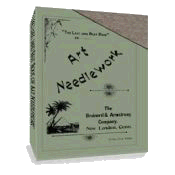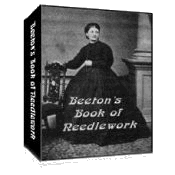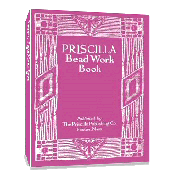All About Etching Embroidery
Etching Embroidery was originally called Print Work, and was much in vogue during the first part of the 19th century. Any specimen of this type of embroidery found today would most probably be those made as framed pictures. It was intended to reproduce, by the aid of Embroidery coupled with Painting, facsimiles of line engravings, and was worked with fine black silk over a sepia tinted ground.
To work: Stretch in an embroidery frame some good white or cream-colored silk, and pencil upon this the chief outlines of a landscape engraving with prominent objects or figures. Take a sable brush, and form the sky by washing in sepia for the darker parts, leaving the surface of the silk untouched for the white clouds; and then color the rest of the picture with washes of sepia, in shades corresponding to those of the engraving. Thread a needle with fine black silk, and commence to cover the painting. Leave unworked all light parts, such as the sky; work the medium tins with run lines of black silk a short distance apart, and work the darkest shades in the Satin stitch close together. Graduate between the medium and the deepest tints with separate Satin Stitches; commence them close together, and end them more apart. Work the foliage of trees in fine French Knots.
Etching Embroidery changed somewhat by the late 1800’s. By then it was worked more in outline than in filled-in embroidery, and was used for doilies and small pictures.

Click on picture to see more detail.
Fig. 1 (above) is an illustration of a pattern intended for a picture, and is worked as follows: Draw the design in pencil upon jean, and tint it with washes of sepia, then outline all the chief parts with fine black silk run lines. Fill in the boat, the oars, and parts of the frogs and lobsters, with run lines close together, and mark out the lily flowers and the veins of the leaves in the same way. If the work is intended to wash, leave out the sepia, and only work in the black silk lines.
The two medallions(Figs 2 and 3, below) were done in another Etching Embroidery style. These were also to be framed, and are entirely worked with black silk, without any painting.

Click on picture to see more detail.
To work: Trace the outlines upon cream-colored silk, and work them over in the Crewel stitch with fine black silk, filling in those parts of the pictures that are represented black. Work the whole of the background with a number of French Knots.
Return to top of Etching Embroidery page.
Return to Types of Embroidery page.
Return to Home page.



 433 pages!
433 pages!

